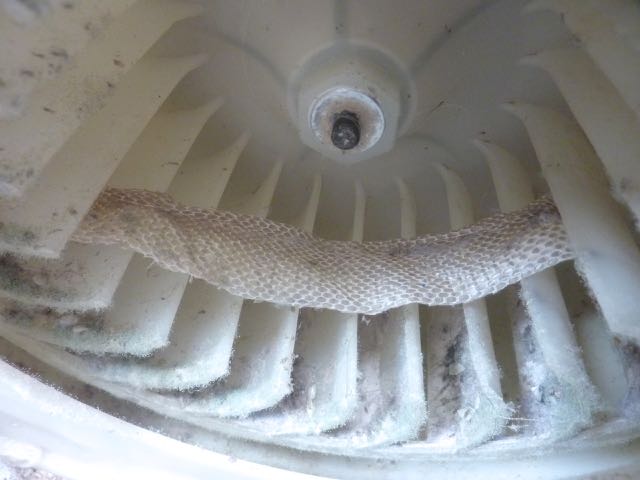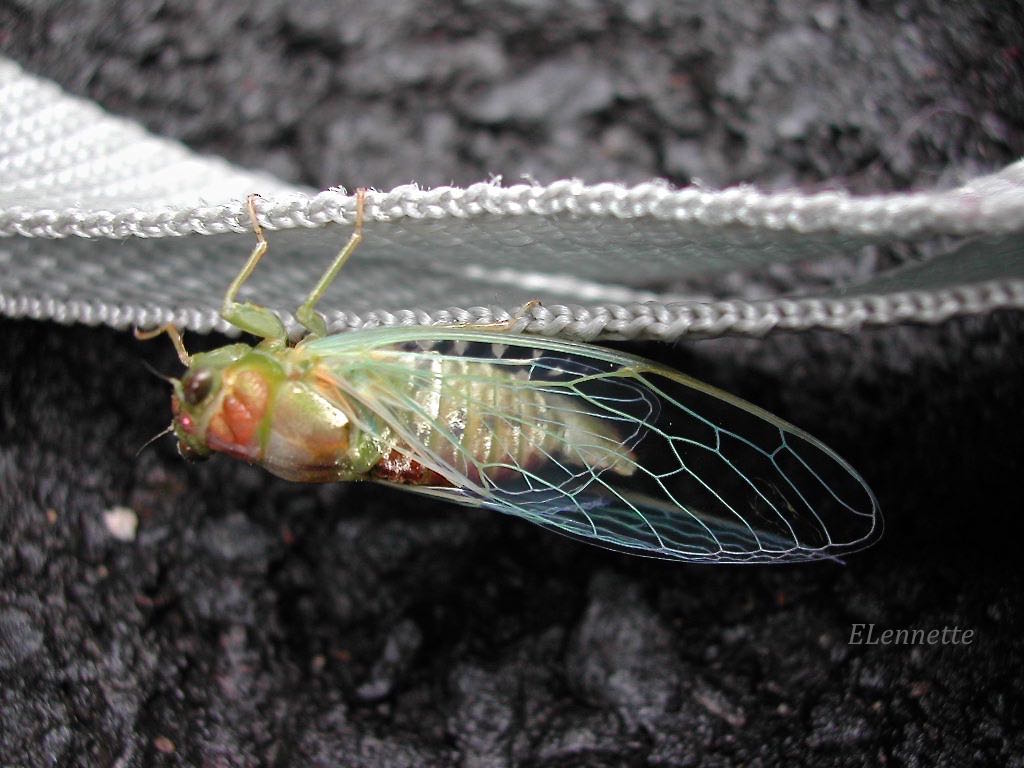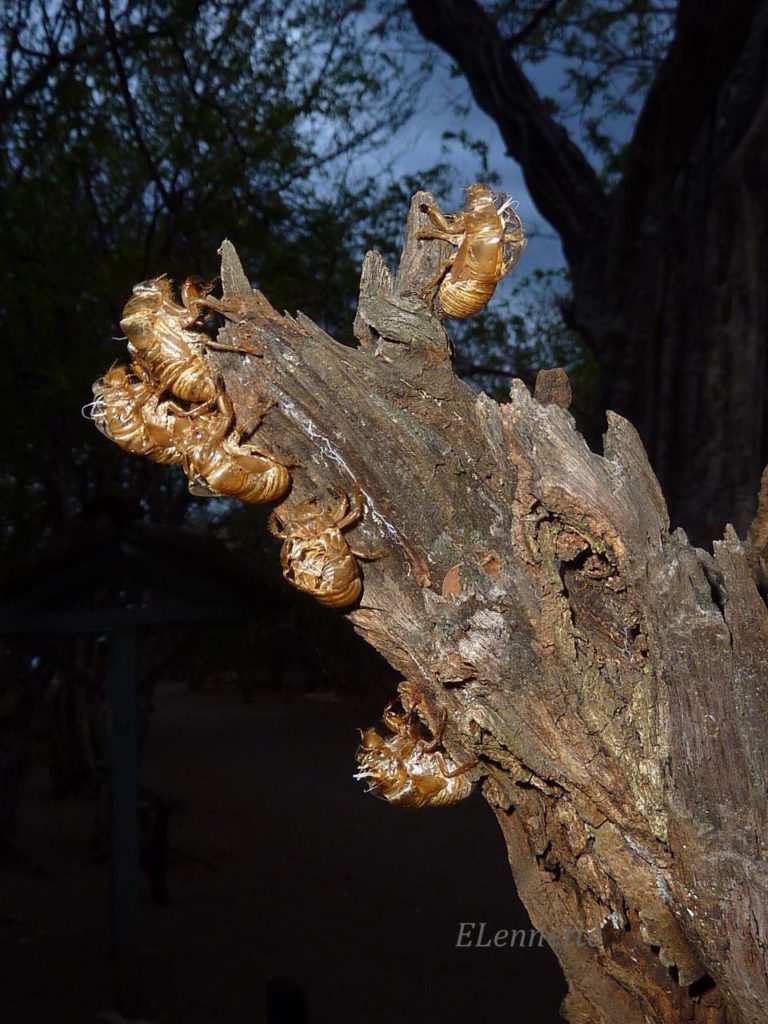Out of Its Skin
Recently, our clothes drier developed an overheating problem. It was simple to diagnose the culprit as a malfunctioning blower fan, but it was a rude shock to discover a 3 feet snake skin, strung across the fan blades, with the head end to the right and out of view in the photo. I was impressed by the intact and clean appearance of the skin, a sign that its owner used the dead fan as the anchor for shedding after the fan died. That was not all. Imagine our surprise to find an additional snake corpse — one similar in size to the first — curled tightly in a ball plastered by caked up lint underneath the drum. This one died, with innards and vertebrae intact, perhaps of heat stroke? (I will come back to snakes molting in a later blog).
These types of inconvenient events are frequent but normal part of living in the tropics. I have learned to take them in stride and even turn them into sparks to light my curiosity fuse. This particular one started me thinking about how differently we humans shed skin.
The outermost layer of our body, the skin, is often referred to as the largest human organ, weighing about 8 lbs (3.6 kg) and constitutes the second largest surface area (intestinal surface is first). It is a protective barrier to prevent water loss and to shield against harmful sun radiation, heat and cold, chemicals and pathogens. But more than a passive barrier, it produces vitamin D, exudes antibacterial substances, and insulates. It is packed with fat cells (fuel, insulation and padding), Langerhans cells (immune sensors), nerves, sensory receptors and blood vessels. Depending on the location, it also has hair follicles and various glands (sweat, oil etc.). Our brain and body depend on it for cues of the outside world, to regulate body temperature, blood flow and our first line of immune defense. We cannot live without it.
Humans grow from two cells (one each from mom and dad) to around 30 trillion cells on average at maturity. To accommodate the increase in body bulk, not to mention the microbiome that we carry around, we shed our skin continuously, seamlessly, effortlessly, one cell at a time, 500 million (~ 0.002%) cells daily for the duration of our life.
This continuous skin renewal is contingent on the presence of the outermost layer, the epidermis. At the base of the epidermis are continuously growing cells. These upward migrating cells eventually die and slough off. Without an intact epidermis, as when injured or diseased, normal human skin regeneration does not occur and results in scarring.
In contrast, growth development in most invertebrates proceeds in multiple, disruptive steps, requiring sharp changes in form and function. Each stage of growth (known as an instar) is necessary to allow for the animal’s enlarging body. Each instar is protected by a skin, and at the final stages, by hard exoskeletons. These transitions take time and energy, during which the animal is vulnerable to attack and predation.
My Jan. 18, 2020 blog showed some of the changes during development of the moth Arsenura batesii, whereby the skin sloughed during the transitions between the caterpillar to pupal stage. The current blog looks at the skin shedding of the cicada.
Cicada
For many visitors to Nectandra at certain time of the year, it is difficult to ignore the synchronized ear-piercing “love song” of the male cicadas (females are silent), the world’s loudest insect, to attract mates. This sound is generated by two oscillating (300-400 times per minute) membranes called tymbals, one on each side of the abdomen just underneath the wings. After mating, the cicada eggs — laid usually on tree branches or trunks — mature, hatch and become nymphs. The emerging nymphs drop to the ground where most of the development takes place. For most species, the nymphs spend 2-5 years underground but some stay as long as 17 years. Not all cicadas have synchronized emergence. Many species have annual cycles. Below are photos of three cicadas species (yet to be identified, out of 45 in Costa Rica) found at Nectandra.
The last subterrestrial nymphal stage eventually emerges, climbs on a suitable tree trunk with camouflage potential, then proceeds to change into its last coat for its mating performance. The next photo captures the perfect out-of-body moment of the cicada emerging from its transparent skin. The different reflected colors off the old and new body from the camera flash give the scene the surreal effect. During ecdysis (skin shedding), the hard exoskeleton split neatly in the back, from which the next stage emerges. Note the body size difference between the transparent cast and the newly emerged cicada.
Often, hundreds of cicada abandoned casts can be seen still attached to trunks of trees.
Ecdysis is a risky process for the animal. For example, the pressure from the pooling hemolymph (fluid analogous to blood) that is needed to split the backside of the exoskeleton (photo below) sometime fails to do the job, causing the emerging cicada to get stuck. Or, parts of the body are injured
during the exit. Or the cuticle of the new body could not harden properly (a three day job) — a condition vulnerable to predation. Ecdysis is very energy intensive. In case of the cicada, the old exoskeleton is abandonned, unlike that of amphibians. The anolis below, in contrast, ate its proteinaceous skin upon shedding.
So, what are the advantages for the multiple cicada development stages? For a start, the soft-bodied nymphs get protection and humidity from being underground where they can attach to tree roots to suck the sap. The variable time underground avoids food competition between the young and adults, and other cicada species. Synchronized emergence from soil facilitates the hunt for mates. Thus, safety, food and sex optimized — just differently from us.







